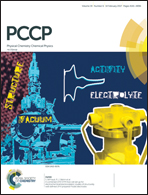Successive lithiation of acetylene, ethylene and benzene: a comprehensive computational study of large static second hyperpolarizability
Abstract
This work is a revisit of the study of the electron correlation effect of lithium substitution on the second hyperpolarizability (106 a.u.) of acetylene, ethylene and benzene. The large quenching of mean second hyperpolarizability has been addressed by CCSD calculations. The inclusion of triple excitation in the MP4 method generally overestimates second hyperpolarizability in comparison to the MP4SDQ method. The present CCSD γav value of C6Li6: 405 × 104 a.u. obtained with a relatively larger basis set established the earlier prediction of Sadlej et al. [Phys. Chem. Phys. Chem., 2000, 2, 3393–3399] where degenerate non-dipolar transitions in low lying excited states play the crucial role. The successive lithiation results in gradual red shifting of transition energy leading to significant enhancement of second hyperpolarizability. Most of the chosen DFT functionals predict the correct qualitative trend of second hyperpolarizability. The quantitatively different results may be attributed to the case when the ground state wave function cannot be approximated by a single SD.



 Please wait while we load your content...
Please wait while we load your content...